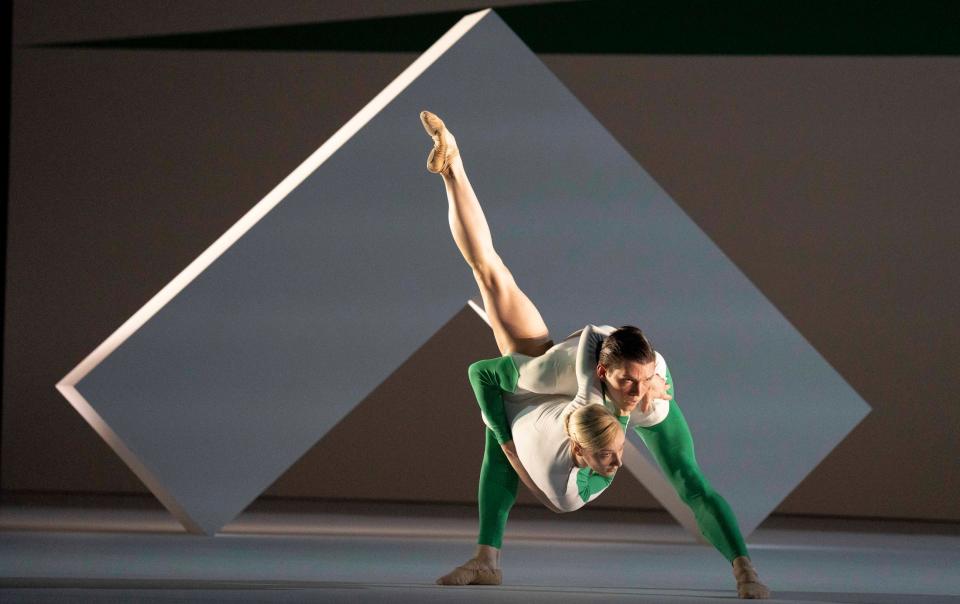Wayne McGregor’s Untitled, 2023 has otherworldly beauty – and a hint of self-regard

There’s something about the title of the new 35-minute work by Wayne McGregor that slightly sets the teeth on edge. Untitled, 2023: it feels archly self-negating, but also rather over-eager for the piece it represents to be regarded as a Work Of Art. Still, what’s in a name? And visual artists have, after all, been deploying the same trope for decades: why should they be entitled to all the untitled fun?
It does, too, arguably suit an ambitious, not entirely unpretentious, curiously hypnotic series of abstract vignettes that see the Royal Ballet’s resident choreographer try his level best to rewire the human body into new shapes, new patterns, new ways of moving. And, though it bears all the familiar choreographic McGregor hallmarks, its sense of mystery is undoubtedly one of its greatest assets.
On uniformly fantastic form, at once relishing and rising to the piece’s athletic challenges, the dancers wear unitards (by Burberry, no less) whose angular patterns cut across the traditional lines of the body. Similarly, a large, flat isosceles triangle (by artist Carmen Herrera, who died last year) spans the backcloth – squint, and it could even be a distant volcano, a sense heightened by the rumbling, primal, mercurial score by Icelandic composer Anna Thorvaldsdottir.
From the eye-catching opening boy’s solo, the steps themselves are no less protean. One moment, heads are balletically high, necks straight, carriage proud; next, shoulders are rounded, necks craned improbably, animalistically forward. A leg is shot gracefully up to a hyper-extended “six o’clock”, but, rather than being lowered with similar lyricism, the joints suddenly seem to collapse, as if internally rearticulated. A pair of dancers greet each other like inquisitive, Merce Cunningham-esque birds; elsewhere, rather magically, a duo alternately, serenely raise their legs like probing sea anemones’ tentacles.
With Lucy Carter’s lighting bathing the action in a series of rich hues, and the only three-dimensional set-cum-prop a large, part-mathematical, part-corporeal right-angle on the left of the stage, the cumulative result is strange, atmospheric and remote, like watching exotic, androgynous alien life-forms from the window of a passing space-ship. (★★★☆☆)

Enjoyable as McGregor’s piece is, Christopher Wheeldon’s returning Ancient Greece fantastia Corybantic Games (from 2018) still comes as something of a relief after it: for its easy, confident neo-classicism, its formal but playful beauty, its fantastic Bernstein score. I still detest the costumes, but look past them and – especially when it’s this eloquently delivered – there’s a wealth of subtly Aegean-tinged choreographic invention here, the Elgin Marbles-like clusters of dancers one highlight among many. (★★★★☆)
Inspired by the real-life case of an ordinary Joe who was convinced she was Russian royalty, the late Kenneth MacMillan’s 1967 standalone Anastasia Act III (★★☆☆☆) is the weakest link here – cruelly so, as you could close your eyes, throw a stick and hit any number of other short works by MacMillan that would have proved the evening’s stand-out. Its dance-theatrical avant-gardery has not aged well, for all that it does suggest a strong understanding of the mechanisms of madness, and here boasts a supremely punchy lead performance from principal Laura Morera, who retires in one week. Intelligence, musicality and dramatic nous have long made her one of the Royal Ballet’s most consistently exciting dancers, and she will be much missed on the Covent Garden stage.
In rep until June 17. Tickets: 020 7304 4000; roh.org.uk

